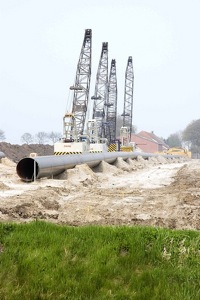 Whenever public debate about natural-gas drilling arises, it has usually revolved around the environmental impacts of high-volume hydraulic fracturing for gas, or “hydro-fracking.” At the same time, most people have taken as a given that the exploitation of new natural gas assets will produce significant economic benefits for the communities surrounding drilling sites. But the economic impact models that analysts have used to project potential benefits and job creation give us only a fraction of the information we need. While we fixate on the environmental impact of natural gas, the equally relevant question of its economic benefits needs closer scrutiny.
Whenever public debate about natural-gas drilling arises, it has usually revolved around the environmental impacts of high-volume hydraulic fracturing for gas, or “hydro-fracking.” At the same time, most people have taken as a given that the exploitation of new natural gas assets will produce significant economic benefits for the communities surrounding drilling sites. But the economic impact models that analysts have used to project potential benefits and job creation give us only a fraction of the information we need. While we fixate on the environmental impact of natural gas, the equally relevant question of its economic benefits needs closer scrutiny.
To fully assess the economic effects, policy-makers and citizens need to confront several key questions that surround the drilling process. What are the implications for job creation, in the short term and in the long term? What costs do communities face in conjunction with gas drilling? What are the likely cumulative effects, not only from the drilling process itself, but also from the industrial infrastructure required? And what are the longer-term consequences of developing an economy dependent on natural gas extraction, and what will happen after the boom-bust cycle of drilling ends?
A closer look suggests that assumptions and analysis about the economic boon that natural-gas extraction can bring to communities sitting on gas reserves can be overly optimistic. While economic models estimate the number of jobs that could be created with a certain level of expenditures on each well, they cannot tell us how many actual jobs will be created, who will get those jobs, or what they will pay. Studies have shown that, when it comes to the drilling itself, gas development will rely mostly on out-of-state workers, except for truck haulers and construction jobs. The direct employment opportunities for locals come from the post-drilling production phase and from the services surrounding the burgeoning industry. While contributing to the economic growth of the community, these new services are by no means easy to marshal. Police forces must be ramped up, school systems must be enlarged, and emergency services must be prepared for the kind of incident that drilling operations can produce, requiring new equipment and training to take on a major hazmat incident.
Indeed, whatever regulation and technical assistance states may provide to municipalities in drilling zones, many of the costs of these efforts still fall on local governments. Particularly worrisome is the fact that these costs are likely to fall on some localities where drilling makes no appreciable contribution to the economy either through job creation or tax revenues. Take, for example, the proposed Seneca Lake gas storage facility just north of Watkins Glen, New York. With underground storage for 1.45 billion cubic feet of natural gas, the complex would play a key role in transporting gas from the Marcellus Shale, which sits beneath communities of southwestern New York and northern Pennsylvania. But Watkins Glen is far away enough from the most likely drilling sites that it is not likely to see a lot of extra tax revenue from well production. Meanwhile, the facility’s construction has the potential to discourage tourism in the Finger Lakes region, and is expected to produce only ten permanent jobs after its construction.
This question of public costs inevitably raises the thorny issue of taxation. Neither Pennsylvania nor New York has a state severance tax on natural gas, but New York does have a local property tax on gas rights. We see here the potential for a schism to develop between the haves and the have-nots among municipalities, as the money from such a property tax will be highly localized, leaving out localities that may share the burden of the extraction process. (Think of communities like Watkins Glen that may not sit on the gas itself, but might have pipelines or infrastructure—obviously vital to the extraction—within their borders.)
On top of all this, there is the “boom-bust” cycle inherent in extraction of any natural resource. The “boom” occurs when drilling crews and other gas-related businesses move into a region to extract the resource. During this period, population increases and there is a modest increase in jobs outside the extraction industry in construction, retail, and services. When drilling ceases, either temporarily or permanently (because the commercially recoverable resource is depleted), there is an economic “bust.” Population and jobs depart the region. The human and physical infrastructure built to support a boomtown population, and its costs, is left for a much smaller population to support. In order for drilling to be economically beneficial to a region, communities, and states need to understand what will influence the pace and scale of drilling and prepare accordingly.
Clearly, a balance of authority and fiscal responsibility will have to be struck between state and local governments to mitigate the harmful economic effects on some communities. Localities will have to negotiate with the state for agreements that protect their interests and those of their citizens. In addition, effective regulation to moderate the speed at which the extraction occurs would be beneficial to avoid the worst effects of the boom-bust cycle. Finally, resource extraction needs to be taxed, and the proceeds invested in developing a more diverse local economy, if gas drilling regions are to wind up better off than they were before.
Photo credit: Harry-Harms
Click to
View Comments